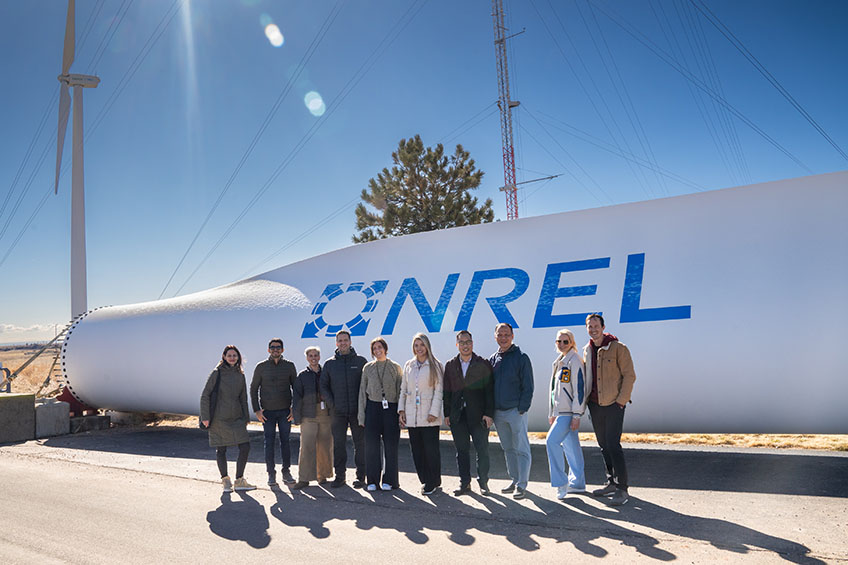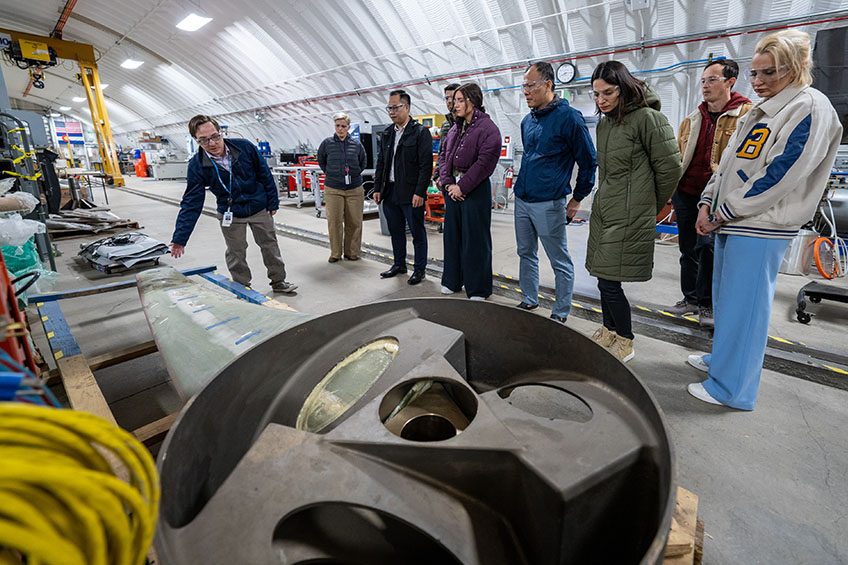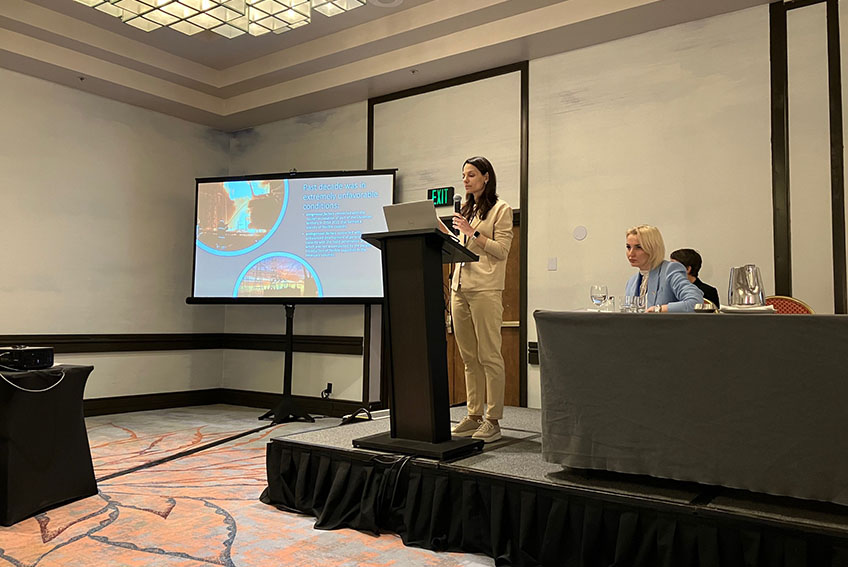Ukraine Fights To Build More Resilient, Renewable Energy System in Midst of War
NREL Is Providing Tools and Technical Support To Help Ukraine Realize a Resilient, Decentralized, Renewable Energy Grid
On Feb. 24, 2022, Ukraine's grid operators were entering into "island mode"—a state of autonomy from other neighboring grid systems—when their country was invaded by Russia. This shift was a test that was part of plans already underway for months to desynchronize from the Russian grid and synchronize with the European Union's.
After the initial invasion, Ukraine operated in island mode until March 16, 2022, when the country was finally able to synchronize its grid to Europe's. A massive undertaking, islanding then synchronizing a grid would typically take a country years—but Ukraine did it in a matter of weeks, made possible in part due to the technical assistance provided by the United States through the U.S. Agency for International Development (USAID) in the years leading up to, and months during and after, the island mode tests.
Grid operators "really made a huge difference when they decided to conduct the trial operation in island mode," said Kateryna Deikun-Stepanchuk, senior engineer in the Department of Balance Reliability at the Ukrainian power company, Transmission System Operator NPC Ukrenergo. "It was really challenging and dangerous, but nevertheless, our Ukrenergo team around all the regions of Ukraine became united in making it happen."
Grid stability is no easy feat even under the best of circumstances. Electric grids are delicately interconnected systems in which the supply of available energy and the use of that energy must be maintained in constant balance. Synchronizing one grid to another requires a precise match of the frequency, phase, and voltage of electric current. Failure to do so could result in grid collapse (a blackout) of both power systems and possibly require weeks of repair to make them functional.

Now, after more than a year of ongoing warfare, Ukraine's power is still on. Crews from Ukrenergo are on call 24/7 to respond to targeted attacks on their grid infrastructure and to address local communities' needs within hours after a missile strike to get power flowing again.
All of this puts Ukraine's power grid operators at the forefront of a multifront battle: "Our heroes are those people who keep our power system going," Deikun-Stepanchuk said.
Not only are grid operators maintaining critical wartime power services, but some have heeded the call to cross over into military operations. "There are many people in our company who joined the army. Very nice guys who work in our office and regional centers. Some of them are very young and could never have imagined that the time would come to hold a weapon in their hands! Never. But they joined the ranks of the Armed Forces," Deikun-Stepanchuk explained. "Unfortunately, we lost many of them. This is our pain. This is our sadness. And these are our heroes forever."
Ukraine is maintaining light, heat, and other power needs while its grid is constantly targeted by missiles and other attacks. Resilience—for the grid, for the people operating the grid, for Ukraine—is essential for the country now and as they look to the future.
Through USAID, the United States works with Ukraine's government, energy private sector, and civil society to enhance Ukraine's energy security and transform Ukraine's energy sector into a modern, market-oriented, EU-integrated engine of growth. USAID is providing direct support to improve Ukraine's energy policy, legal, and regulatory environment and makes direct investments in the electricity, gas, and heat sectors.
In partnership with USAID, the U.S. Department of Energy's National Renewable Energy Laboratory (NREL) is supporting deployment of renewable-generation-based microgrids that will enable Ukraine to increase its energy independence and resilience by integrating more renewables into its energy mix.
How Renewables Can Help Ukraine Become More Energy Resilient
Ukraine's aging grid has been a challenge to maintain even before the war brought targeted attacks. Before the invasion, NREL was supporting the USAID Ukraine mission and Ukrainian officials on modernization plans to transition to greater renewable energy penetration.
Renewable energy can build a more resilient energy system in two ways:
- Renewable energy can diversify energy sources away from fuels, like diesel, that must be supplied.
- Renewables allow for building distributed energy systems—decentralizing the grid, which enables it to be more resilient to disruptive events, such as extreme weather or attacks.
But "renewables don't inherently make a grid more resilient," said Eliza Hotchkiss, researcher and resilience and energy security analyst at NREL. "They need to be designed to be more resilient."
The USAID-NREL Partnership's original goal in Ukraine was to: (1) provide technical support and data analysis for distribution systems siting and project investment decisions, and (2) help plan for bringing more wind and solar onto its nuclear-dominant system to meet Ukraine's decarbonization and energy independence targets and to align with the European Union's targets for a clean hydrogen-based energy future.
Needs quickly changed with the invasion.
Keeping the Lights On—Today
"So much of that planning went to the back burner after the invasion," said NREL researcher Ilya Chernyakhovskiy. "Then, the focus became: What can we do on our side that's helpful now? There's much more of a here-and-now mentality and a response to immediate circumstances."
As attacks continue, a priority in Ukraine is to maintain electricity supply at key facilities—like hospitals and schools—and at thousands of "points of invincibility" that allow residents to warm themselves or charge personal electronic devices when their home's power is out.
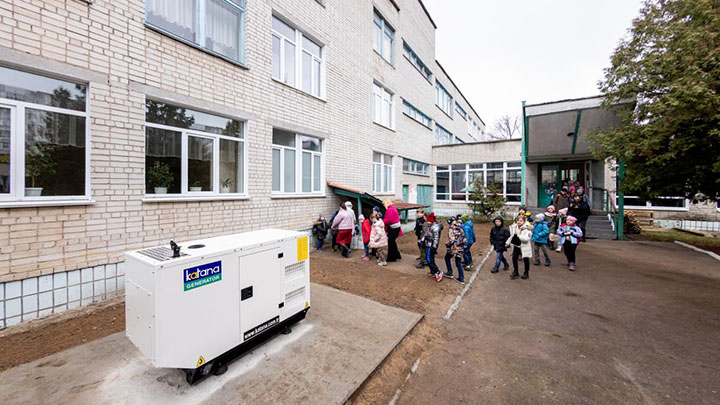
Most of these key facilities have diesel backup generators that kick in when grid power goes out, which require a steady stream of diesel fuel to operate. Adding solar power to a diesel-generator-powered microgrid can significantly reduce fuel use and extend its operation without refueling. For example, a 2021 NREL study found that pairing solar generation with a diesel generator could potentially extend operation twofold, from an initial seven days to almost 14 days.
NREL is working with USAID, the Ministry of Energy of Ukraine, and the Ministry for Communities, Territories, and Infrastructure Development of Ukraine to design a microgrid pilot project that will demonstrate how a solar photovoltaic (PV)-plus-storage system could enhance resilience under the present conditions in Ukraine. NREL is providing technical assistance on sizing the solar-plus-storage system for the load, and USAID will provide financial support to build the pilot project.
Hopefully, the project will inspire and inform more such installations once it is operational.
Building a More Resilient Energy System for Tomorrow
Looking further into the future, NREL and USAID are planning to help Ukraine and its power system operators build a cleaner and more resilient energy system. But this will take time, as NREL has experienced through its disaster recovery portfolio.
"With a lot of disasters, we see people in the aftermath feeling 'recovery fatigue' or 'conflict fatigue' where they are exhausted and can't think about much beyond survival," Hotchkiss said. "So right now, we're just reminding Ukrainians that we are here and ready to help when they are ready to plan and rebuild."
Despite the invasion, in March 2023, Ukraine set a goal to have 50% of its power from renewable energy sources and 50% from nuclear energy by 2035. Hotchkiss and Chernyakhovskiy meet regularly with the USAID Ukraine mission to discuss how goals for renewable energy and energy efficiency are maintaining or changing during the war.
In March 2023, Ukrenergo staff members Kateryna Deikun-Stepanchuk and Liubov Lapko joined other system operator staff from Colombia and Vietnam for a 10-day study tour at NREL's campus, hosted by the G-PST Consortium.
To start, staff from Ukrenergo are already engaging with the Global Power System Transformation (G-PST) Consortium, which brings together power system operators from around the world to share ideas and solutions for decarbonization. NREL serves as G-PST's secretariat and its lead organization for providing technical support to partnered system operators in emerging economies, such as Ukraine. UkrEnergo staff are actively participating in G-PST's peer-learning program, which includes visits to NREL to meet with NREL researchers and staff from other power system operators.
With funding from USAID, NREL has recently published solar resource data for all of Ukraine. This data—showing the average amount of sunlight received over the course of the year in four-square-kilometer resolution—serves as the foundation for many other NREL-developed software platforms that help size and design solar and solar-plus-storage systems.
The most popular of these, PVWatts®, has been translated into the Ukrainian language, to enable any Ukrainian to see how much energy solar PV panels on their building could generate. Updating the PVWatts tool for the Ukraine partnership involved collaboration with teams across many of NREL's research capacities, from the Center for Integrated Mobility Sciences, to the Grid Planning and Analysis Center, to the Strategic Energy Analysis Center.
For now, the underlying solar resource data comes from just three years of satellite observations (2017–2019), but the NREL solar resource team will expand this to 20 years of data soon. NREL teams will also be adding other renewable energy resource data for Ukraine to the RE Data Explorer platform that allows people around the world to assess their local renewable energy potential and inform renewable energy development decisions. Critically, wind resource data is anticipated to be added for Ukraine by early 2024.
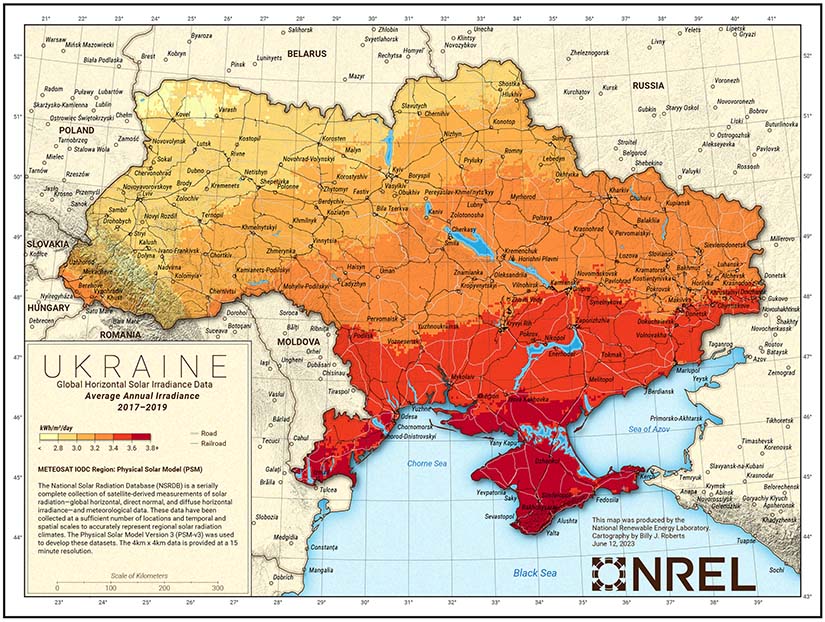
While U.S. technical support to Ukraine might not get the same level of attention as its defense support, these data sets are crucial for Ukrainians to envision and enact a clean energy transition for their country in a systemic way.
"The U.S. is supporting Ukraine with more than just weapons," Chernyakhovskiy said. "We have technical expertise in the power system that is relevant to Ukraine and that will help Ukraine rebuild."
How Ukrainians Can Take Advantage of USAID and NREL Energy Sector Resources
USAID’s large energy program in Ukraine covers a wide range of activities in the electricity sector, such as power system planning and operation, synchronization with the European Network of Transmission System Operators for Electricity, market development and integration to Europe, as well as recovery and development of the transmission and distribution networks.
USAID procures energy and repair equipment and technical expertise to strengthen Ukraine’s energy sector. For more information, visit energysecurityua.org/tenders.
USAID has written multiple reports making assessments of and recommendations for Ukraine’s energy sector, made its technical presentations available for the public, and published a series of videos on renewable energy issues and a course on careers in the energy sector.
Through partnership with USAID Ukraine, NREL has made PVWatts available in Ukrainian and hosted an informational virtual webinar about using the tool with Ukraine solar resource data.
Watch the event recording: Ukrainian.
Watch the event recording: English.
For questions specific to PVWatts, email [email protected].
NREL is also offering an Ask-an-Expert service that connects local communities and stakeholders in Ukraine with experts at NREL to assist with infrastructure and energy system rebuilding efforts. The Ask-an-Expert service provides remote consultation on rebuilding and recovery, and energy security and resilience topics. NREL's subject matter experts provide these services via phone, email, or videoconference at no cost to the requester.
For Ukrainian users, contact Ask an Expert at [email protected].
Universal Lessons in Resilience and Beyond
When engaging in communities rebuilding after a disaster or conflict, NREL staff are strategic in their approach.
"We don't just go into a community and say, 'Here is a solution,'" Hotchkiss said. "We work with local stakeholders to determine what will work in their context and culture."
That illustrates NREL's approach to designing all its international programs: driven by country- or community-level priorities, underpinned with training to build local expertise, and intended to draw out universal lessons that can inform future analysis.
"It isn't all about what NREL can offer. With every one of our efforts abroad, we are learning from our peers in other countries and adding to our own bank of knowledge and experience," Chernyakhovskiy said.
For example, USAID and NREL can draw from previous experience supporting resilience and recovery in Providencia Island, Colombia. When a Category 5 hurricane damaged 98% of the island's energy infrastructure, the USAID-NREL Partnership was asked to join a collaborative working group alongside local ministries to create a plan for Providencia to rebuild its power system to be more climate resilient and renewable-energy dominant.
NREL conducted a capacity expansion analysis to understand the opportunities and impacts of integrating renewable energy and energy storage on Providencia Island's remote power system and published a series of white papers meant to inform Colombian officials' decision-making throughout the island's clean energy transition.
Like Ukraine, Colombia sought to convert a disaster into an opportunity to rebuild Providencia's grid better than before. The two countries may be thousands of miles apart, but they have in common access to assistance from USAID and NREL to support their energy transitions at every step.
While much remains uncertain about Ukraine's day-to-day needs and realities, what is clear is that there are more than just lessons about energy system resilience to learn from NREL's experience. For Chernyakhovskiy, it is the resilience of the Ukrainian people that he says will stick with him.
"I'm endlessly impressed by their ability to keep going through it all."
Last Updated May 28, 2025




